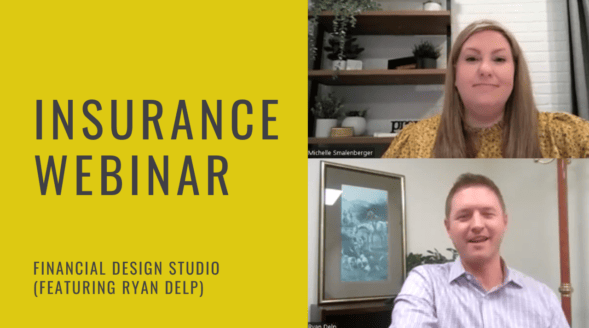What goes in, What comes out? Life Insurance [Video]
by Trevore Meyer, CFP® / April 19, 2021Thank you for joining me in our second life insurance series video. If you haven’t had the opportunity to watch the first video I would encourage you to go back and watch that before you watch this one. Quick reminder at Financial Design Studio we do not sell any insurance for clients. That said, we do review insurance as a critical part of each client’s financial plan. This video is all about what goes in and what comes out with life insurance?
Did you know that with your life insurance policy your premium isn’t exactly your cost? That’s crazy right? It doesn’t seem to add up. As we went through before on our prior video with a term contract you’re fine. Your cost is exactly what your premium is. Apart from maybe if you have some rider costs on top of it as well. Suffice it to say all the money you put in you’re not using for a savings account. With a permanent policy, however we do have that option.
It’s important to be mindful of premiums vs. costs. We are going to get into those specifics in a minute. First I want to go through how we can evaluate the term contract and the costs underneath it. Let’s also see what is a good policy as well as what is maybe a not so great one.
What goes in?
For today let’s use the example that John went out to a couple insurance companies and got some quotes. Let’s say company B and company C. For company B we requested a quote and we got an offer of $750,000 for a cost of $875/year. That’s great, but is that a good price, we really don’t know and need to compare it to something. From company C we got a quote for a policy of $950,000 at $1,300/year. Now we need to figure out which policy is the better one. In this case we are going to use a calculation called the cost per thousand. This is simply the total cost which is $875 or $1300, over the number of thousands for each of the policies.
Term Policy Calculation
For company B policy it would be $875/$750 and we are left with 1.25. We then do the same calculation for Company C, $1300/$950 and we get 1.37. Which one is better? If you step back and think about this we want to pay less to get the same amount from either side. We are paying less cost per thousand with company B so that’s the company we want to go with.
Now what if John needed additional coverage? They only offered $750,000. The way we would handle that is we would go back to the insurance company and say hey thanks for the offer. Ask if we can we increase that base amount from $750 to $950? In this situation as long as they maintain a similar cost per thousand, or even lower, we are in good shape. That is still a better offer than Company C. So as you are going through the different offers from companies keep this calculation handy. It’s a way to determine is this a good offer or not so great.
Permanent policy calculation
Now let’s switch over to permanent policies. I talked a little bit before about how part of your premium goes towards your policy costs and part of it goes to the cash value. This calculation gets a little bit more challenging to do but we can still get close.
We are going to take our most recent two annual statements for the policy and look at how much we paid in premium over a full insurance policy year. After that, we are going to take out how much the cash value increased and any dividends. Then we are going to hone in on what the actual policy costs were. Now we can actually determine what those policy costs were and divide that by the face amount of the contract. Even still, this is not an exact calculation as we will get into with some later videos as well.
What comes out?
So far we have talked a lot about what goes into a contract but not so much about what comes out. I think it’s also important to note that while we are going to be using a permanent contract, how can we get money out of it assuming we are building up that cash value. Now, if you have a term contract or you are evaluating one you are fine. The only way to get money out of the term contract is unfortunately to pass away. There is no cash value to draw from.
A permanent contract does get a little bit more challenging. With that being said we do have some options available to us. With the cash value we have two primary options those are going to be policy withdrawals or policy loans.
Policy Withdrawals
Let’s take a look at withdrawals. Let’s say we’ve had a contract for 10 years and we’ve been paying $3,500 a year into it. Our basis in that contract is $35,000. Now let’s say the cash value is $50,000. If we want to take out all $50,000 when you withdraw from your policy’s cash value essentially what you are saying is you are requesting the money back out of the contract. Now assuming we are taking less out of the contract than what we put in. We are fine there are no taxes due. We get all that money paid back to us. Apart from maybe some admin charges during the transaction. Now if our cash value has grown beyond what we have paid in terms of premiums there may be some taxes due. You need to be mindful of that before we decide to execute that withdrawal. This will ensure we know what our tax picture is going to look like that year.
Policy Loans
Now with the loan option things are a little bit different but not too much. With loans you can actually take up to 90% of your policy cash value out as a loan, assuming your contract offers it. Most do. The trouble here is let’s say you run into a situation where your policy may lapse or you get the policy surrendered. With a policy loan you can take out up to 90% of the policy’s cash value and you don’t have to worry about the taxes. However if you run into a situation where you either surrender the contract or it lapses you might have a gain. Because it doesn’t have enough in the cash value to pay the insurance if there is a gain in what you put in and what that cash value was. That amount would become taxable to you similar to as if it was going to be a withdrawal. This is something to keep in mind and be aware of before you execute any of these transactions.
The decision on the best course of action for you really comes down to what contract do you have available. Also what the provisions are and most importantly what your entire financial picture looks like. After discussing this in more depth hopefully you can see what goes in and what comes out with life insurance policies. However, we are going to be looking a little bit more in depth about the details associated with base amounts and some of the other things to be looking out for with your contract.
Please stay tuned and be looking out for the next two videos in this series. I do hope you found this video of what goes in, what comes out in life insurance policies helpful. And if you have a contract that you would like to review or you have additional questions please reach out to us we would be more than happy to help.
Ready to take the next step?
Schedule a quick call with our financial advisors.
Recommended Reading
Insurance Webinar
Our insurance webinar walks you through the basic insurance policies, what you may be missing, and an audience Q&A session.
Endorsements for Your Insurance Coverage [Video]
In this excerpt, Ryan Delp, insurance agent with Bradish Associates, breaks down insurance endorsements he looks to add for extra coverage.

Trevore Meyer, CFP®
Trevore has nearly a decade helping families with their financial planning needs. He is incredibly passionate about helping folks visualize and explore what their ideal lives look like and following it up by helping them get there.

